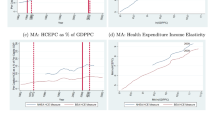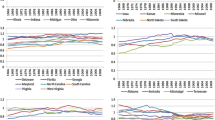Abstract
Based on a structural VAR model estimated with Bayesian methods over the period of 1985Q1–2017Q1, we investigate the effects of health care policy uncertainty (HCPU) on the US health sector. We find that HCPU exerts a negative and significant impact on the growth rate of real health expenditures and health care inflation. It has an especially persistent effect on health care inflation and explains a generous portion of the post-2007 decline in the growth rate of health care services prices in the USA. HCPU also dampens the growth rate of GDP and general inflation, eliciting cautiousness from economic agents and acting as a negative aggregate demand shock.











Similar content being viewed by others
Notes
We implement the Bayesian VAR estimation with the MATLAB codes of Koop and Korobilis (2010).
Examples of other key terms used by Baker et al. (2016) include health care, Medicaid, malpractice tort reform, malpractice reform, prescription drugs, drug policy, food and drug administration, FDA, prescription drug act, medical insurance reform, medical liability, part D, affordable care act, and Obamacare.
In a separate exercise, we place the Canada variable last in the Cholesky decomposition and assume that shocks to the health sector in Canada have a lag effect on the USA. This is consistent with the fact that Canada is a small open economy and it is more likely that the USA, which is a larger economy, imposes contemporaneous effects on Canada than the other way round. The responses of the US variables based on this exercise are similar to what is shown above and are consistent with our baseline model.
JMulTi software by Lütkepohl and Krätzig (2004) is used for the estimation.
References
Baker SR, Bloom N, Davis SJ (2016) Measuring economic policy uncertainty. Q J Econ 131(4):1593–1636
Baltagi BH, Moscone F (2010) Health care expenditure and income in the OECD reconsidered: evidence from panel data. Econ Model 27(4):804–811
Baltagi BH, Lagravinese R, Moscone F, Tosetti E (2017) Health care expenditure and income: a global perspective. Health Econ 26:863–874
Barati M, Fariditavana H (2018) Asymmetric effect of income on the US healthcare expenditure: evidence from the nonlinear autoregressive distributed lag (ARDL) approach. Empir Econ. https://doi.org/10.1007/s00181-018-1604-7
Bech M, Christiansen T, Khoman E, Lauridsen J, Weale M (2011) Ageing and health care expenditure in EU-15. Eur J Health Econ 12(5):469–478
Bloom N (2009) The impact of uncertainty shocks. Econometrica 77(3):623–685
Caggiano G, Castelnuovo E, Groshenny N (2014) Uncertainty shocks and unemployment dynamics in US recessions. J Monet Econ 67:78–92
Caggiano G, Castelnuovo E, Figueres JM (2017) Economic policy uncertainty and unemployment in the United States: a nonlinear approach. Econ Lett 151:31–34
Carrion-i-Silvestre JL (2005) Health care expenditure and GDP: Are they broken stationary? J Health Econ 24(5):839–854
Clemente J, Marcuello C, Montañés A, Pueyo F (2004) On the international stability of health care expenditure functions: Are government and private functions similar? J Health Econ 23(3):589–613
Cuckler GA, Sisko AM, Keehan SP, Smith SD, Madison AJ, Poisal JA, Wolfe CJ, Lizonitz JM, Stone DA (2013) National health expenditure projections, 2012–2022: slow growth until coverage expands and economy improves. Health Aff 32(10):1820–1831
de la Maisonneuve C, Moreno-Serra R, Murtin F, Martins JO (2017) The role of policy and institutions on health spending. Health Econ 26:834–843
Dolmas J (2016) Health care services depress recent PCE inflation readings. Econ Lett Federal Reserve Bank of Dallas 11(11):1–4
Felder S, Tauchmann H (2013) Federal state differentials in the efficiency of health production in Germany: An artifact of spatial dependence? Eur J Health Econ 14:21–39
Gulen H, Ion M (2016) Policy uncertainty and corporate investment. Rev Financ Stud 29(3):523–564
Hartwig J (2008) What drives health care expenditure? Baumol’s model of ‘unbalanced growth’ revisited. J Health Econ 27(3):603–623
Herring B, Trish E (2015) Explaining the growth in US health care spending using state-level variation in income, insurance, and provider market dynamics. INQUIRY J Health Care Organ Provis Financ 52:1–11
Jakovljevic M, Potapchik E, Popovich L, Barik D, Getzen TE (2017) Evolving health expenditure landscape of the BRICS nations and projections to 2025. Health Econ 26:844–852
Jewell T, Lee J, Tieslau M, Strazicich MC (2003) Stationarity of health expenditures and GDP: evidence from panel unit root tests with heterogeneous structural breaks. J Health Econ 22(2):313–323
Kang W, Lee K, Ratti RA (2014) Economic policy uncertainty and firm-level investment. J Macroecon 39:42–53
Koijen RS, Philipson TJ, Uhlig H (2016) Financial health economics. Econometrica 84(1):195–242
Koop G, Korobilis D (2010) Bayesian multivariate time series methods for empirical macroeconomics. Found Trends Econom 3(4):267–358
Lago-Peñas S, Cantarero-Prieto D, Blázquez-Fernández C (2013) On the relationship between GDP and health care expenditure: a new look. Econ Model 32:124–129
Leduc S, Liu Z (2016) Uncertainty shocks are aggregate demand shocks. J Monet Econ 82:20–35
Lorenzoni L, Belloni A, Sassi F (2014) Health-care expenditure and health policy in the USA versus other high-spending OECD countries. Lancet 384(9937):83–92
Lütkepohl H, Krätzig M (2004) Applied time series econometrics. Cambridge University Press, Cambridge
Moscone F, Tosetti E (2010) Heath expenditure and income in the United States. Health Econ 19:1385–1403
Moses H, Matheson DH, Dorsey ER, George BP, Sadoff D, Yoshimura S (2013) The anatomy of health care in the United States. J Am Med Assoc 310(18):1947–1964
Murthy VNR, Okunade A (2016) Determinants of US health expenditure: evidence from autoregressive distributed lag (ARDL) approach to cointegration. Econ Model 59:67–73
Murthy V, Okunade A (2018) Is the health care price inflation in US urban areas stationary? Evidence from panel unit root tests. J Econ Finance Adm Sci 23(44):77–94
Okunade AA, Murthy VN (2002) Technology as a ‘major driver’ of health care costs: a cointegration analysis of the Newhouse conjecture. J Health Econ 21(1):147–159
Pástor L, Veronesi P (2012) Uncertainty about government policy and stock prices. J Finance 67(4):1219–1264
Potrafke N (2010) The growth of public health expenditures in OECD countries: Do government ideology and electoral motives matter? J Health Econ 29(6):797–810
Spithoven AH (2009) Why US health care expenditure and ranking on health care indicators are so different from Canada’s. Int J Health Care Finance Econ 9(1):1–24
Stock JH, Watson MW (2012) Disentangling the channels of the 2007–2009 recession. Natl Bureau Econ Res 81–135
Wang KM (2011) Health care expenditure and economic growth: quantile panel-type analysis. Econ Model 28(4):1536–1549
Yagihashi T, Du J (2015) Health care inflation and its implications for monetary policy. Econ Inq 53(3):1556–1579
You X, Okunade AA (2017) Income and technology as drivers of Australian healthcare expenditures. Health Econ 26:853–862
Acknowledgements
The authors would like to thank Somtip Watanapongvanich for her excellent research assistance, and we would like to thank the anonymous reviewers for their useful suggestions.
Author information
Authors and Affiliations
Corresponding author
Ethics declarations
Conflict of interest
The authors declare that they have no conflict of interest.
Additional information
Publisher's Note
Springer Nature remains neutral with regard to jurisdictional claims in published maps and institutional affiliations.
Rights and permissions
About this article
Cite this article
Cheng, C.H.J., Witvorapong, N. Health care policy uncertainty, real health expenditures and health care inflation in the USA. Empir Econ 60, 2083–2103 (2021). https://doi.org/10.1007/s00181-019-01818-x
Received:
Accepted:
Published:
Issue Date:
DOI: https://doi.org/10.1007/s00181-019-01818-x




